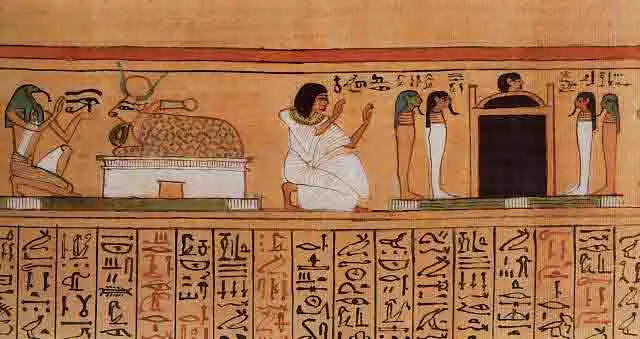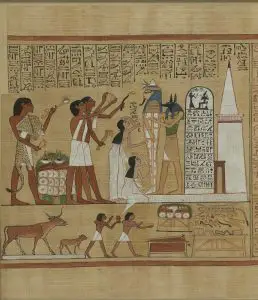The ancient Egypt book of the Dead Spells is not exactly a book. It is more like a collection of mortuary prayers selected on an individualistic basis. It is usually inscribed on the sarcophagus and the walls of the tomb of the individual. Therefore, at best, it can be said to be just a different name for a bunch of different magical spells written down in various ways by the ancient Egyptians. The term “book” is used not because it was an actual book, but because of the reason that these prayers were written on rolls of papyrus which resembled an Egyptian book.

The earliest known versions date from the 16th century BC during the 18th Dynasty (ca. 1580 BC-1350 BC). It boasts of partial incorporation of two previous collections of Egyptian religious literature, known as the Coffin Texts (ca. 2000 BC) and the Pyramid Texts (ca. 2600 BC-2300 BC), both of which were eventually superseded by the Book of the Dead. Later additions included prayers to the Sun God, Re.
The credit of finding the first and the existing copy of the Book of the dead goes to Sir E. A. Wallis Budge. In 1888, he found a tomb at Luxor dating back to the 18th Dynasty. Here, a perfectly preserved papyrus scroll, written at around 1500 B. C. for Ani who was Royal Scribe of Thebes, Overseer of the Granaries of the Lords of Abydos, and Scribe of the Offerings of the Lords of Thebes was found. It was a copy of the Egyptian Book of the Dead. However, the text of the Book of the Dead was first deciphered by Karl Richard Lepsius in the year 1842. He was the one who assigned the name the Book of the Dead.
Why was the Egyptian Book of the Dead important?
Safely reaching the afterlife was something all Egyptians wanted. It was believed that the afterlife was a real place, and they believed magical spells would help them get there. It was a set of mortuary prayers to protect and help the deceased in the afterlife. The Book of the Dead was meant for the rulers in the Old Kingdom but eventually began to be used by the nobles, officials, and lesser folk of the Middle Kingdom. There are over 190 prayers and new prayers continue to be found, meant to suffice the needs of the dead. Some spells occur more frequently than the others. One such spell is the Spell 17, discussing the importance of the Sun God: Re.
Spells or enchantments vary in distinctive ways between the texts of differing “mummies” or sarcophagi, depending on the prominence and other class factors of the deceased. What first appeared as prayers inscribed on tombs and walls and sarcophagi eventually began to be written on papyrus scrolls by the New Kingdom. The last known copies of the Book of the Dead were created in the first and the second century A.D. Some of the people couldn’t afford to have them noted down but instead had it read out to them as an alternative.
The prayers in the Book of the Dead are not gender-specific and has no prayer specifically attached to a particular gender. This could hint at the belief that after death all humans become equal no matter there gender. Although this might be a little progressive to think since the Book of the dead mainly were meant for those belonging to the ruling classes.
Contribution of “Book of the Dead”

Books of the Dead constituted as a collection of spells, charms, passwords, numbers and magical formulas for the use of the deceased in the afterlife. This described many of the basic tenets of Egyptian mythology. It also incorporated Magic Spells relating to the safety of the heart and soul of the deceased and also included a spell to open the tomb for the soul and to let a man return to see his house on earth.
The spells in the book were written to guide the dead through the various trials afterlife that they would have to cross before reaching the underworld. It was essential to have knowledge of the appropriate spells achieve happiness after death. It was not meant to explore the underworld but rather to understand the experiences of transformation and transcendence. After a person died, it took somewhere around 70 days to prepare the mummy of the dead pharaoh. After this, the process where the Book of the Dead would be used came about. After the burial, the first prayer read out from the Book of the Dead was that referred to as the “Opening of the Mouth” which was meant to resurrect the dead in a new form known as “Aankh” who would take up the journey in the afterworld. It follows the path of Sun God, Re, believed to have travelled from the West to the east underground everyday. During this journey his boat, which he used to travel, was attacked by a snake Aapep, which tried to defeat Re. The defeat of Re would mean the ceasing of the sun to rise in the sky. Hence Aapep had to be defeated by Re everyday. Now with a prefix -Osiris attached to the name of the deceased (the term used came from the name of the God of the underworld Osiris, the husband of Isis), The soul of the dead reached a set of seven doors. It is now when the Book of the Dead comes to the rescue of the dead. They can read out a correct specific prayer which when correct would open the correct door. Once the deceased has crossed the correct door, he or she now appears in the “Court of the Two Truths.” Here Osiris along with 42 other Gods and Godesses sit for the trial of the deceased. Here, the deceased has to disclose what sins he has not committed in his lifetime. He must have committed some crime, just like any other people and hence confessing them is a lot simpler. The confession of what sins one has not committed makes the test way more challenging for all and hence is practiced. Here they have to list all the sins they have not committed. If they do so flawlessly, they are finally tested by Osiris himself. Egyptian Mythology placed great importance on the heart and hence even when mommies were made they were not removed from the body of the dead and even if by mistake they were removed, they would be placed back as had happened in case of Ramases II. In this test by Osiris the heart of the deceased, without which they couldn’t have walked the journey in the afterworld, was weighed. Anubis, the God of mummification, placed the heart of the deceased on one side of the balance and an ostrich feather, taken from the crown of the Goddess of Justice Maat, on the other side of the balance. If the side with the heart proved to be lighter than the other side, perhaps meaning that the heart was pure and free of guilt and sins, then the dead, having passed the test, could have a happy life in the “Du’at”, something similar to the concept of heaven. Here, all the sides were laid down with fences and the deceased were basically imprisoned. This place was a place with rivers, barley fields, mountains and so on with an immense quantity of scenic beauty. But unlike the concept of heaven in other regions with only ultimate rest and happiness, here the deceased has to work in the fields to cultivate barley and bring water from the rivers and so on for the Lord. If the deceased belonged from the class of the Pharaohs, then he or she could delegate his work to other deceased people in the ranks lower than him. Thus it is clear that in ancient Egypt, even after death the concept of division of labour and the class system stayed seen in the Pharaohs assigning their jobs to others. Other small dolls were placed inside the Sarcophagus of the Pharaoh since it was believed that when the Pharaoh’s soul was ressurected, these ritualistic dolls would also wake up and work for the Pharaoh. However, if the deceased failed in the examination of Osiris and their heart was heavier than the ostrich feather, then their heart would be eaten up by Monster Amit. They would be stuck in the underworld forever and would come up on earth occassionally and scare people and sometimes try to get rid of the vicious cycle that he or she is trapped in. They will never have a release.
The magic spell 156 from the Book of the Dead relates to the power of the Goddess Isis and was recited over a knot amulet made of red jasper which was placed over the heart on the body of the deceased for protection against wickedness, sometimes referred to as the Isis Amulet. Quite a number of spells of the Book of the Dead instruct on how to use the spells in the living world, suggesting its usage in the living world too. Later on, the Book of the Dead inspired another set of funerary texts known as the “Book of the Breathing.”